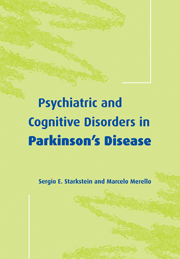Book contents
- Frontmatter
- Contents
- Preface
- 1 Introduction
- 2 Epidemiologic, clinical, and therapeutic aspects of Parkinson's disease
- 3 Parkinsonism and Parkinson's disease
- 4 Cognitive deficits in Parkinson's disease
- 5 Depression in Parkinson's disease
- 6 Anxiety, phobias, apathy, and premorbid personality in Parkinson's disease
- 7 Neuropsychologic and psychiatric side-effects of antiparkinsonian medication
- 8 Treatment of psychiatric disorders in Parkinson's disease
- Appendix
- References
- Index
5 - Depression in Parkinson's disease
Published online by Cambridge University Press: 13 August 2009
- Frontmatter
- Contents
- Preface
- 1 Introduction
- 2 Epidemiologic, clinical, and therapeutic aspects of Parkinson's disease
- 3 Parkinsonism and Parkinson's disease
- 4 Cognitive deficits in Parkinson's disease
- 5 Depression in Parkinson's disease
- 6 Anxiety, phobias, apathy, and premorbid personality in Parkinson's disease
- 7 Neuropsychologic and psychiatric side-effects of antiparkinsonian medication
- 8 Treatment of psychiatric disorders in Parkinson's disease
- Appendix
- References
- Index
Summary
In his Essay on the Shaking Palsy, James Parkinson (1817) stated that patients may become demoralized by the disease and may eventually refuse treatment. Janet (1924) was the first to recognize an explicit association between depression and PD, and explained the mood disorder as secondary to psychologic trauma.
In this chapter we will examine the phenomenologic aspects of depression in PD and discuss its prevalence, main clinical correlates, longitudinal evolution, and potential mechanisms. We will begin with a clinical case that features most of the usual manifestations and problems arising from depression in PD.
Clinical vignette
O.B. is a 74-year-old engineer who was referred to a neurology clinic because of gait problems and falling episodes. His motor problems had started 1 year before, when he noticed more rigidity in his right upper and lower limbs and a tendency to fall toward the right. On neurological examination he showed hypophonia, slight loss of facial expression, intermittent resting tremor in his right hand, mild cogwheel rigidity restricted to the right side, mild slowing on finger tapping, hand movements, and leg agility, moderately stooped posture, slow shuffling gait, and mild postural instability. The patient reported that several years before the onset of the motor problems he became more apathetic and lost interest in his everyday activities. At the onset of parkinsonian signs he also developed a depressive mood, and reported feeling sad most of the time, with difficulties in falling asleep, loss of interest in activities of daily living, worrying about minor matters, difficulties in concentration, and loss of energy and libido. […]
- Type
- Chapter
- Information
- Psychiatric and Cognitive Disorders in Parkinson's Disease , pp. 88 - 113Publisher: Cambridge University PressPrint publication year: 2002
- 1
- Cited by



